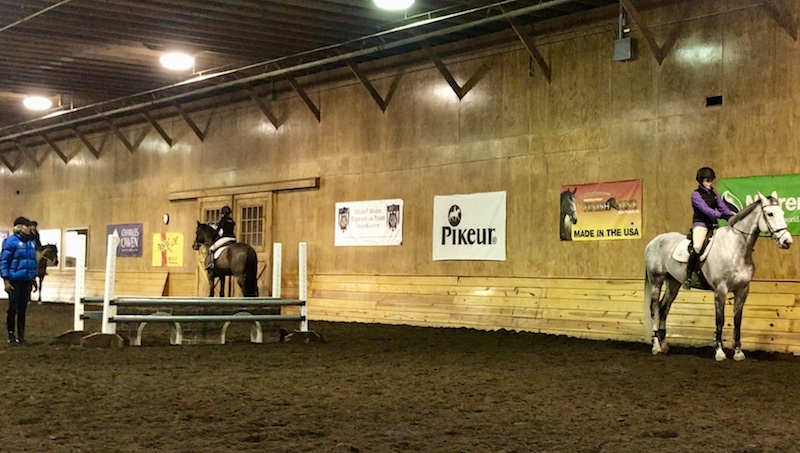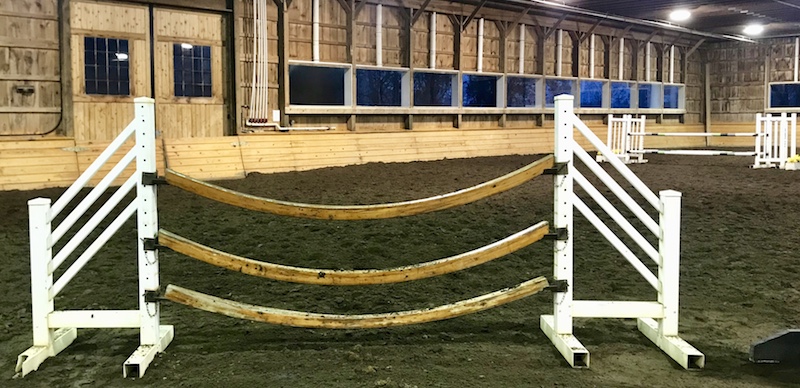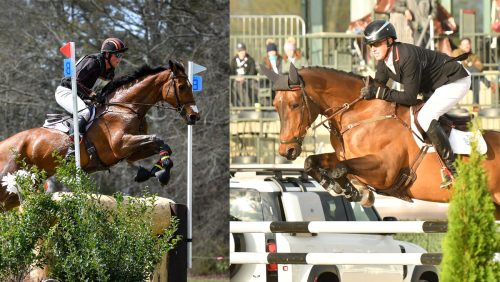Proper position and effectiveness of the aids were still the focal point on the second day of Anne Kursiski’s three-day clinic at her Market Street Inc., in Frenchtown, N.J.
Themes from the first day, like body awareness and control, came into play when the riders started jumping over a short course of jumps. Anne said, “If you can’t control your body on the flat, it will be worse when you jump. You need to be an effective rider. It’s not just about looking good. Can you lengthen [the stride], can you shorten, can you move them left and right with minimum effort? That’s why your flatwork is important: that you’re using your aids correctly and you’re getting a reaction from the horse.
“Proper flatwork is like going to the gym. It gets them stronger, it makes them stay sounder. They get easier to ride because they mind the leg, they mind the rein. So when you go to jump, they listen,” Anne said.

Katherine Pugliese working without her stirrups during the warm-up. Photo by Kiira Lizza
As on Day 1, riders warmed up on the flat with and without stirrups. Anne expressed that as riders flatted around, they needed to ask questions like, “How is your rein length? Where are your heels? Is your horse bent left or right?” All riders rode leg yields, shoulder-ins, and turns on the forehand and haunches to get the horses listening to the leg.
A couple of riders had difficulty executing the turn on the forehand and haunches perfectly. Anne advised, “It comes from the leg. Your hands stay together like with the knot in the reins exercise. Don’t just stick your spur in and leave it there—it’s the intermittent use of the spur to get them listening and reacting. So often when things are not going well, the horses are getting mixed messages. Feel the horses and their reactions. You have to have clear communication.”

Anne Kursinski (left) helping Victoria Holtz on her grey horse with the turn on the forehand. Photo by Kiira Lizza
During a short flatting and jumping walk break, Anne emphasized, “It’s not just riding, it’s about being a good horseman or woman. Asking little questions make a difference. How do your horses’ coats look? Are they up to date with the worming and the shoeing? Are you in contact with the vet? All these little things will help you have a better partnership with your horse.”
She also stressed the importance of the rider being a physically fit partner for their horses. “I am a big fan of going to the gym and doing Pilates and yoga,” she said. “The chiropractor and massage for the horses and the rider are important. A lot of times when the rider is crooked and they get adjusted, they come back and ride straighter! How can you be the best partner to your horse? By being fitter, by being stronger. And sports psychology goes along with that as well.”
ADVERTISEMENT
Riders started jumping off the left lead over a low swoop jump on the diagonal and halting on a straight line in the corner. Anne had the riders start counting out loud when they thought they were eight strides out and focus on sitting tall in the halt.
They then jumped the swoop and continued on the right lead over a green oxer on the opposite diagonal, still counting out loud.

The swoop jump with the right-hand bending line to the oxer. Photo by Kiira Lizza
Then left lead out of the turn to a green and white square oxer, six strides at 83′, to a grey vertical. Anne stressed riding into the corners, as riders in all three sections cut the turns. She said, “After one jump is the beginning of the next jump. The turn is the beginning of the next jump.”
Riders then cantered left lead up over a grey oxer with brick walls underneath, bending in six or seven strides at 81′ to a log jump with a rail on top. Anne had the riders do the line in seven strides to start, turn right, roll back to the original green oxer in the opposite direction and then the same oxer-to-log line in six strides. For riders that were having difficulty, Anne added spurs, a stick, and took a noseband off a bridle.

Victoria Khaghani practicing her halt. Anne Kursinski removed this horse’s figure-eight noseband later on in the lesson. Photo by Kiira Lizza
The riders got the job done and the horses were happier with the correct equipment. “Sometimes you need a bigger spur, a stick, more bit. Sometimes you need less. Listen to the horses. I watch the horses and from how they are going is how I teach,” Anne said.
With the second and third groups, Anne had the riders turn their hands over and use driving reins with an automatic release, stressing to stay off the horses’ necks, but still with them over the jump, using their core strength for balance.

Having riders hold the reins in a driving rein grip is one of Anne Kursinski’s favorite exercises. Photo by Kiira Lizza
When riders had difficulty, Anne knotted the reins again saying, “The knot helps you stay up there with him. You’ve got to stay with the horse in your two-point for balance. You don’t see a jockey on a racehorse leaning back, they’re with the horse. Get quiet with your body.”
ADVERTISEMENT
To demonstrate her point, Anne hopped on a mare whose rider was having trouble with the proper two-point position. Anne jumped the same exercise with light contact and position. Then to show that she really does not need the horse’s neck for balance, Anne dropped her reins and put her arms straight out to the side before she jumped the jump! “I never rode her before, but I am my own balance,” Anne said after the ride.
The riders then started left lead over the grey vertical, left rollback on the swoop in the opposite direction, five direct strides at 71′ to the green and white oxer, turned right and jumped the liverpool out of the turn, four strides at 58′ to a one-stride combination of verticals 24′ apart.
The riders had difficulty finding a smooth distance to the first three jumps. Anne said, “Line the turn up for the jump. Jump the first left to right, jump the swoop, and stay in so the five is nice.” For riders who had trouble getting up the lines, Anne stressed that riders needed to react and use their legs more effectively to communicate clearly to the horse that they wanted to move up the line.
When Anne had them jump the log to the grey oxer in a short seven strides, some riders had trouble fitting the seven in. Again, Anne stressed the importance of body control and communication saying, “Because you collapse in the air, it takes you two or three strides to get her back and then you have to stuff the seven strides in. Get her back as you land. That’s mental awareness. Have a plan. It’s a mental exercise to do something a little different.”
Lastly, the third group circled over the swoop jump practicing counting out loud. Anne had them start with counting only one stride out and working up to eight strides out. Again, the riders were to stay off their horses’ necks. They focused on breathing, looking in through the turn to the swoop and following their horse to the jump. When asked what the riders learned from the exercise, they said they were softer in their arms, quieter with their upper bodies and that their horses were more sensitive to the aids without the rider being busy.
Clear communication and effectiveness of the aids lead to invisible riding. Anne said, “The top, top riders look like they are doing nothing. Whether that is show jumping, eventing, dressage, or hunter riders. It’s an art. McLain Ward could win Medal Finals, Beezie Madden could win Medal Finals. You watch Nick Skelton, and he never sits down. He’s the best rider in the world.”
Read more about Day 1: Control Your Position To Control Your Horse and Day 3: Get It Done.
Finish Line live streamed each day of the advanced section of the Nov. 17-19 clinic and those videos are available on demand at www.ridingandjumpingmentor.com.














